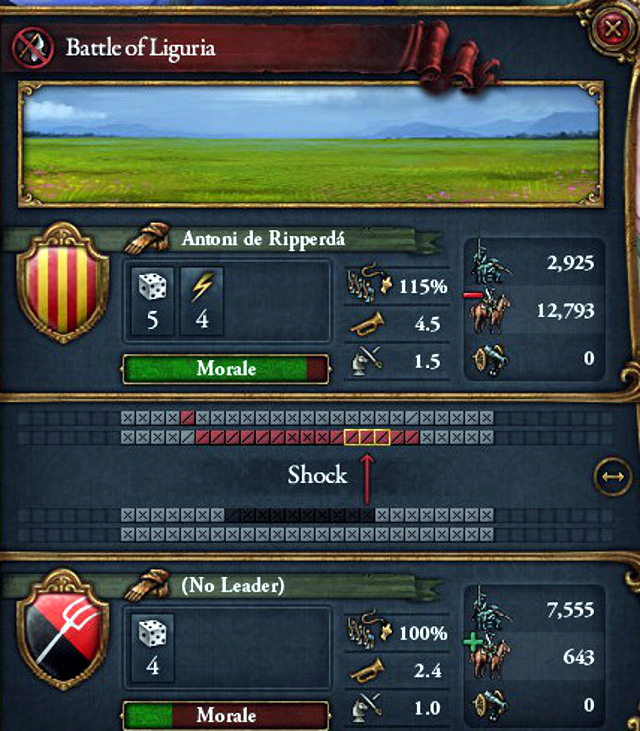The Army | The Army
Last update:

You cannot fight battles in EU IV so, even if you are a military genius, you will not benefit from it. The fate of battles is in the hands of the game's mechanics and luck. Still, t is a good idea to reinforce these two factors to the extent it is possible. First of all, it is important to organize your army and choose your units properly. During a battle, clashes are fought along the predetermined length known as the combat width, which is divided into two rows (the above screenshot). Armies in the first row fight against each other, by default with the regiment in front of them. High maneuverability acquired from technology and the leader, will allow the unit to attack sideways also, and thus flank the enemy, which you can view by rolling your mouse over a specific unit (square). In the screenshot, one unit of rebel infantry can attack three cavalry units. The base maneuverability of infantry is 1 (which means that it can attack enemy directly infront of it, on its left and on its right). For cavalry the value is 2, but the factors rise basing on technology and a good leader. The range of maneuverability also depends on the current manning of a given regiment. It acquires it's full maneuverability with 75%. You achieve half the potential with 75-50%. If a unit less than 25% strong, it cannot flank the enemy . Infantry and cavalry that stay in the second row, do not participate in the fights and, that is why combat width is more favorable to smaller armies. CW is appropriately smaller, depending on the size of a province. For example, in mountainous areas, it is smaller by, as much as 66% so, this is a considerable handicap for defenders who cannot be flanked and, at the same time, attacked by several units at the same time. . this answers the question of why, while fighting in mountains, defenders are capable of defeating enemy armies larger in numbers. The only type of unit that can attack while in the second row is artillery. It is worth noting that artillery does not slow down the army, unlike in the previous installments. The unit speed remains the same regardless of whether it has cannons or not. Therefore, you do not need to worry about this factor. The artillery that remains a t the back, can easily lay fire on the enemy without sustaining any losses. Still, if it makes it to the first line, by accident, it becomes very vulnerable and receives twice as much damage so, it can be easily destroyed. That is why the army make-up is so important. You should have sufficiently enough units in the first line to keep cannons in the back. Furthermore, the make-up is important due to the appropriate balance between infantry and cavalry. Infantry is the basic unit for armies of that period so, if you have lots of cavalry, you will receive a special modifier - Insufficient Support. This will decrease your military tactic by 25%! The balance factor depends on the technological group and it amounts to:
- Western Group- maximum amount of cavalry is 50% of the current infantry
- Eastern - 60%
- Turkish- 50%
- Islamic - 80%
- Indian - 50%
- Chinese - 50%
- Nomad - 100%
- Sub-Saharan- cannot own cavalry
- The New World - 50%
The make-up of the army is a key to success. There are many opinions on how to best make up your army, and what works best here is experience, as well as own preferences. In general, a good solution here is armies between 15 and 20 thousand, or even 25- 30 thousand, depending on wear, technology and finances. Mostly, it should be composed of infantry. Per each 15K you can try solutions like 9 infantry, 3 cavalry and 3 artillery (with possibly more cavalry). In spite of appearances, cavalry is not that effective a solution. For more than twice the price of infantry, it offers not much more, and much less than the slightly more expensive artillery. Of course, you should always have some units for flanking available but, in general, when you develop financially, I recommend that you prefer artillery e.g. for an army 20 thousand strong - 10 infantry, 2 cavalry and 8 artillery. It pays off to have as much artillery as possible to fill in the second row, and keep it completely covered in front. Not only does artillery attack without taking damage, but also reinforces, offensively, the first row at the cost of a half of its defense! At the same time, you should always have some infantry reserves, which will fill in the gap in the front row if necessary, and some unit is rendered incapable of fighting.
You should also consider the terrain and the country you play as, while making up the army. E.g. Poland, due to hussars, has formidable cavalry available and in this case, the above ratios are not going to be that effective. It is a way better idea to play here, e.g. 4-6-5. On the other hand, if you are going to fight a defensive battle in the mountains, cavalry is completely useless and you can have artillery and infantry in equal proportions (with maybe more infantry in reserve).
Siege
Whenever you take over a province, you initiate siege. Every preset amount of days (the base number is 30) there is a die roll which determines what happens in the castle, starting with status quo, through deficiencies in supplies, food, water, to surrendering the fort. You can speed up the siege if you have an appropriate leader, by blocking local harbor and by owning lots of artillery. Next to the fort, you will find information, expressed in percents, of how possible it is that the fort will be surrendered.
If you do not want to wait, try storming the enemy fort. Only infantry takes part in storming. It is a very expensive maneuver and it is virtually unprofitable with low technology levels but, with the passing years, it is increasingly more effective. First of all, you should make sure, before storming that there is a crack in the wall. Storming undamaged walls practically equals sending all of your soldiers to a slaughter and can be successful only in the case of enormous advantage in numbers. If there actually is a crack, storming will be expensive but, it will be successful with numbers of your armies three or four times higher.
Mercenaries
If you are hard pressed on deploying armies and replenishing losses, you can enlist mercenaries. You can recruit mercenaries only once a month and they do not use up Manpower. The access to these is limited to specific number of units a month , and they are also 50% more expensive to recruit than their national counterparts. They are also 1.5 times more expensive to maintain. The 50% higher cost of recruitment is negligible and it makes no difference, but maintaining them may botch you up, even if your country is rich and, that is why you should never base your army on mercenaries in peacetime. It is simply best to disband such units. In the wartime, they can still prove to be immensely useful, especially to rich countries with low Manpower. You can modify mercenaries through appropriate ideas and, additionally, some countries like Byzantium, Burgundy and Sweden have national ideas that decrease their cost. In the case of such countries, with ideas developed, you can easily wage wars basing on mercenaries only.
You are not permitted to copy any image, text or info from this page. This site is not associated with and/or endorsed by the Paradox Interactive or Paradox Interactive. All logos and images are copyrighted by their respective owners.
Copyright © 2000 - 2025 Webedia Polska SA for gamepressure.com, unofficial game guides, walkthroughs, secrets, game tips, maps & strategies for top games.
